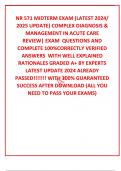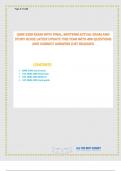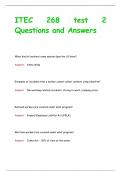NR 571 MIDTERM EXAM (LATEST 2024/
2025 UPDATE) COMPLEX DIAGNOSIS &
MANAGEMENT IN ACUTE CARE
REVIEW| EXAM QUESTIONS AND
COMPLETE 100%CORRECTLY VERIFIED
ANSWERS WITH WELL EXPLAINED
RATIONALES GRADED A+ BY EXPERTS
LATEST UPDATE 2024 ALREADY
PASSED!!!!!!! WITH 100% GUARANTEED
SUCCESS AFTER DOWNLOAD (ALL YOU
NEED TO PASS YOUR EXAMS)
,
, A 52-year-old male patient has been admitted to the heart failure unit with new atrial fibrillation (AF),
volume overload, and hypoxia. This is his first admission for heart failure (HF), and during intake he
denies a past medical history of hypertension, hyperlipidemia, or myocardial infarction. All of the
patient's immediate family members are alive and well. There is no family history of heart disease,
sudden death, or infiltrative disease. The patient jogs regularly and denies anginal symptoms or
syncope. The patient endorses alcohol use for 20 years and states that he has tried to cut down recently.
Based on this information, what is the most likely cause of the patient's new heart failure?
A.Ischemic dilated cardiomyopathy
B.Hypertrophic cardiomyopathy
C.Restrictive cardiomyopathy
D.Takotsubo cardiomyopathy
Answer: A. Ischemic dilated cardiomyopathy
The patient’s presentation is most consistent with ischemic dilated cardiomyopathy related to alcohol
use. Ischemic dilated cardiomyopathy is more common in men and often presents with development of
arrythmia like AF. His only risk factor for heart failure is alcohol use, which is a secondary cause of
ischemic dilated cardiomyopathy. Hypertrophic cardiomyopathy is often asymptomatic at rest, although
symptoms may occur during strenuous exercise. It most commonly presents in those in the third decade
of life. Additionally, hypertrophic cardiomyopathy runs in families, and the patient denies any history of
heart disease in his family. Restrictive cardiomyopathy is associated with a number of etiologies,
including infiltrative disease, which the patient denies. It also presents with a history of poor exercise
tolerance, which is not consistent with the patient’s history of present illness. Takotsubo
cardiomyopathy is associated with extreme emotional stress and often manifests with anginal
symptoms, which does not fit the patient’s presentation.
Adults with a history of congenital heart disease (CHD) are at risk of what common complication?
A.Deep vein thrombosis (DVT)
B.Myocardial infarction
C.Heart failure
D.Stillbirth
Answer: C. Heart failure
Patients with a diagnosis of CHD are monitored frequently for the development of heart failure. While
DVT can be a result of an unrepaired congenital heart defect, this is not considered a common
, complication in most adults. Myocardial infarction is not a frequent complication in CHD. Some women
with a concurrent diagnosis of CHD and pulmonary arterial hypertension (PAH) are counseled against
pregnancy due to the risk of maternal death; however, development of heart failure is of concern to a
wider group of these patients.
While rounding on a 70-year-old patient recently admitted with community-acquired pneumonia, the
AGACNP notes an ulcer on the medial malleolus. The ulcer bed is shallow, and the borders are irregular.
The surrounding skin is notable for hemosiderin staining, with +1 edema to both lower extremities.
What is the most appropriate treatment?
A.Compression therapy, wound care consult, and elevation of the affected limb
B.Pain control, debridement, and surgical consult
C.Wound care consult, frequent position changes, and a pressure-reducing mattress
D.Antibacterial ointment, wet to dry dressing, and wound care consult
Answer: A. Compression therapy, wound care consult, and elevation of the affected limb
A shallow-based ulcer with uneven edges present at the medial malleolus is consistent with venous
statis. Compression therapy and elevation are mainstays of treatment. Pain control, debridement, and
surgical consult are indicated in the management of arterial ulcers, whereas the patient’s symptoms and
signs are more consistent with an ulcer related to venous insufficiency. Frequent position changes and a
pressure-reducing mattress are appropriate in the setting of a pressure ulcer, not a venous ulcer.
Compression dressings, not wet to dry dressings, are the mainstay of treatment for venous ulcers. There
is no indication for antibacterial ointment.
The AGACNP sees a 44-year-old patient who is unconscious, has an advanced airway in place, and is
actively receiving cardiopulmonary resuscitation (CPR). The patient's only known history is for alcohol
use disorder and tobacco use. The patient is cachectic-appearing with diminished muscle mass. After
completion of a 2-minute round of CPR, the AGACNP calls for a rhythm and pulse check. The rhythm on
the monitor appears to be a multi-focal ventricular tachycardia (VT) with a twisting type of pattern.
Based on this patient's known history and the most likely arrythmia, what treatment does the AGACNP
order?
A.Epinephrine intravenously (IV)
B.Amiodarone IV
C.Magnesium IV
D.Atropine IV
Answer: C. Magnesium IV






